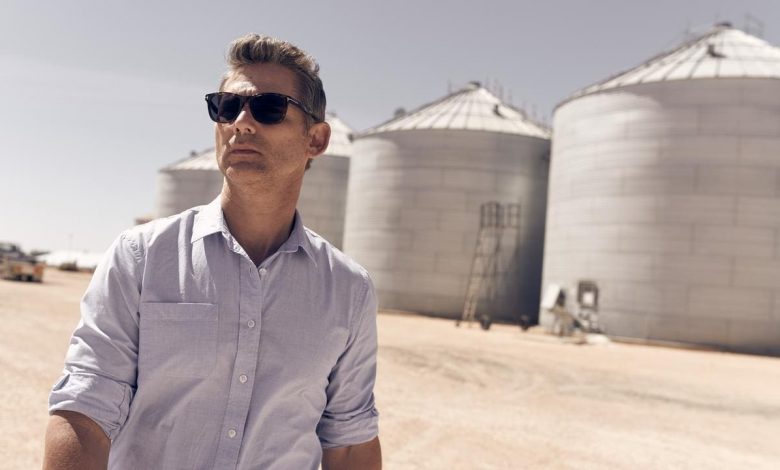The Dry movie: Eric Bana on his bond with regional Victoria and shooting on location

news.com.au- Eric Bana may be a city boy, but he feels the pull of the country.
Those country landscapes of regional Victoria, the craggy shapes of the bush and the open spaces of the tinder dry fields, are splashed all over the screen of bush noir The Dry, Bana’s latest film, adapted from Jane Harper’s best-selling novel.
The appeal of the film is as much about the vivid, moody sense of place it evokes as it is the mysterious deaths that drive the plot of the film.
Shot in the Mallee Wimmera region of northwest Victoria, it’s the stand-in for the fictional hometown of Bana’s character Aaron, a Melbourne-based federal cop who returns home for the funeral of his childhood friend.
There are questions around the deaths and the tensions present in the stricken town – some long simmering, some brought on by the devastating drought – threaten to tear it apart.
“There is another version of this film that exists 50 minutes outside of a metropolitan area where you can cheat it and still make a great movie, but you wouldn’t see the movie that you’ll see,” Bana told news.com.au.
“I don’t like being indoors in a studio. Locations really bleed into your character, your performance and your energy. It’s really special.”
Bana, 52, said he was partly drawn to The Dry because of Harper’s depiction of regional Australia in her book.
“It’s the regional Australia that I recognise, not the outback. I really spend a lot of time out in the regional areas on my motorcycle, so a lot of these places are places I’ve spent a fair bit of time in and just love. I feel very passionate about it.
“So, I had a very emotional response to the material as a result.
“Then, obviously, when you’re embedded there [filming], you get into the rhythms of country life, even though you’re working. You’re remote and you’re having these beautiful one-hour-and-15-minute drives from the little town that you’re staying in, to the town that you’re shooting in each day, experiencing the sunrise and the sunset and the beauty of it. It gets under your skin.
“It was a major adjustment coming back to life in Melbourne after that, and lockdown was even harder as a result of having spent time in the region. I was dying to get back out there, into the regions.”
He was quick to add, “I behaved myself, I didn’t break any rules. But, boy, oh, boy, there was a couple of vanishing-point moments!”
It’s a scale that is breathtaking on a cinema screen, an experience that can’t be replicated on a TV screen at home, let alone on your mobile phone.
The Dry, like so many films in 2020, was originally intended for release earlier, in its case in April. As the world locked down and cinemas shuttered, an August date was mooted before settling on January 1, traditionally a busy moviegoing time of the year which would usually be crowded with Hollywood blockbusters.
But with coronavirus cases escalating in large markets including the US and the UK and big movies further pushed, The Dry finds itself in an enviable position in that it’s only up against Wonder Woman 1984 in terms of a high-profile competitor.
“We now have this incredible opportunity on January to open at a time without there being 10 American blockbusters in the same week,” Bana said.
Also, as an Australian film, the decision to release it in cinemas now was not being made by executives in Los Angeles whose priorities are firmly focused on the US.
While the threat of a second wave in Greater Sydney has made audiences reticent to flock to a cinema, the rest of the country is open for business, and for moviegoing.
Even though most international tentpole movies have been withheld these past nine months, Australians have had the fortune to sample smaller, independent fare but also a smattering of local films.
These local releases during the pandemic, including Rams, Babyteeth and the upcoming Penguin Bloom, have been a reminder why it’s so important that there is a robust Australian screen culture.
“I think by about halfway through 2021, there is a pretty impressive runway of Australian films that’s being released and we’re the first of them,” Bana said. “It’s why I really hope for many reasons our film is a huge success. I hope it paves a way to help with those other releases.
“I’m hoping that the industry will look back on itself and say, ‘hey, Australian audiences really warm to these projects’. They’re original pieces of material of really high quality that have a broad audience in mind.
“Let’s see if people flock to them and if they do, there’s a reassessment [of the local industry] hopefully.”
Up-and-comer actor Joe Klocek, who plays a younger version of Bana’s character Aaron in The Dry, agreed that the pandemic has highlighted the value of the local screen industry.
“One thing we’ve learnt from the pandemic is that Australia can hold its own. We’re creating a lot of great work,” Klocek said.
“And I think the pandemic has actually made the rest of the world realise that we are an invaluable asset to have. That’s one thing I’m really excited about when The Dry comes out. I hope people get to cinemas and see it because it just says, ‘This is what we can do, look at this’.”
Bana added the allure of Harper’s book will hopefully prove to be a selling point for moviegoers in supporting a local production.
“We always thought that there could be a massive audience for Jane Harper’s book. It was our job to try and make the biggest cinematic version to try and lure people into the cinema.
“Every decision made on that film is made with a big screen in mind, right down to the sound and everything. That’s what we want to be part of.”



